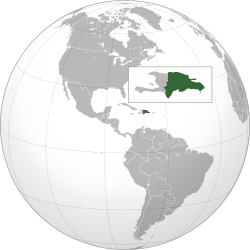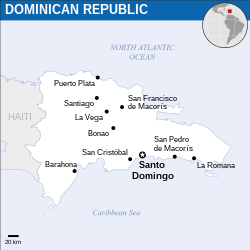
Back Доминиканатәи Ареспублика Abkhazian Dominikaanse Republiek Afrikaans Dominikanische Republik ALS ዶሚኒካን ሪፐብሊክ Amharic Dominica AMI Republica Dominicana AN Dominicanisce Cynewise ANG डोमिनिकन गणराज्य ANP جمهورية الدومينيكان Arabic لجمهورية د الدومينيكان ARY
Dominican Republic República Dominicana (Spanish) | |
|---|---|
| Motto: "Dios, Patria, Libertad" (Spanish) "God, Homeland, Freedom" | |
| Anthem: ¡Quisqueyanos Valientes! ¡Valiant Quisqueyans! | |
 | |
 | |
| Capital and largest city | Santo Domingo 19°00′N 70°40′W / 19.000°N 70.667°W |
| Official languages | Spanish |
| Ethnic groups | |
| Demonym(s) | Dominican Quisqueyan (colloquial)[1] |
| Government | Unitary presidential republic[2] |
| Luis Abinader | |
| Raquel Peña | |
| Legislature | Congress |
| Senate | |
| Chamber of Deputies | |
| Independence | |
• from Haiti | January 24, 1856[3] |
• from United States | July 12, 1924b |
• from United States | November 28, 1966[4] |
| November 28, 1966 | |
| Area | |
• Total | 48,315 km2 (18,655 sq mi) (128th) |
• Water (%) | 0.7[2] |
| Population | |
• Estimate | |
• Density | 228/km2 (590.5/sq mi) |
| GDP (PPP) | 2018 estimate |
• Total | $186.983 billion[5] |
• Per capita | $18,164[5] |
| GDP (nominal) | 2018 estimate |
• Total | $81.653 billion[5] |
• Per capita | $7,932[5] |
| Gini (2015) | medium |
| HDI (2015) | medium · 99th |
| Currency | Peso[3] (DOP) |
| Time zone | UTC – 4:00[2] (Standard Time Caribbean) |
| Driving side | right |
| Calling code | +1-809, +1-829, +1-849 |
| ISO 3166 code | DO |
| Internet TLD | .do[2] |
The Dominican Republic (Spanish: República Dominicana) is a Latin American country on the Caribbean island of Hispaniola; the other country on the island is Haiti. Its capital, and largest city, is Santo Domingo. The national language is Spanish.
The country was part of the Spanish empire until the late 18th century. In the 19th century France, Spain and Haiti controlled it at various times, and later it was independent. It was occupied by the United States from 1916 to 1924. The Dominican Republic is a presidential democratic republic. The country has a tropical climate but modified by elevation and the trade winds (winds that come from the northeast, from the Atlantic Ocean).
The Spanish brought African slaves to the country.
Dominican Republic is one of the biggest producers of cacao.
- ↑ Roorda, Eric Paul (April 28, 2016). Historical Dictionary of the Dominican Republic. Rowman & Littlefield. ISBN 9780810879065 – via Google Books.
- ↑ 2.0 2.1 2.2 2.3 2.4 "CIA – The World Factbook – Dominican Republic". Central Intelligence Agency (CIA). Archived from the original on February 13, 2016. Retrieved June 4, 2007.
- ↑ 3.0 3.1 3.2 "Embassy of the Dominican Republic, in the United States". Archived from the original on 2015-06-26. Retrieved February 27, 2009.
- ↑ Historia de la República Dominicana. Ediciones Doce Calles, S.L. 2010. p. 409. ISBN 978-84-00-09240-5. Retrieved 1 July 2013.
- ↑ 5.0 5.1 5.2 5.3 International Monetary Fund. "Gross domestic product based on purchasing-power-parity (PPP) valuation of country GDP". Retrieved 12 July 2018.
- ↑ "GINI index (World Bank estimate)". World Bank. Retrieved 12 December 2017.
- ↑ "Human Development Report 2016" (PDF). United Nations Development Programme. Retrieved March 21, 2017.
- ↑ Convenios bilaterales entre la República Dominicana y Haití [Bilateral arrangements between the Dominican Republic and Haiti] (PDF) (in Spanish). Ministerio de Relaciones Exteriores de la República Dominicana. August 2000. pp. 15–17. Archived from the original (PDF) on October 22, 2014. Retrieved October 22, 2014.
- ↑ Varios autores (2012). Ruptura y reconciliación. España y el reconocimiento de las independencias latinoamericanas [Rupture and reconciliation. Spain and the recognition of Latin American independence] (in Spanish). Penguin Random House Grupo Editorial España. pp. 30, 206. ISBN 978-84-306-0257-5.

